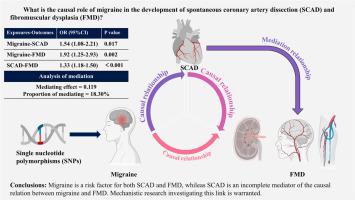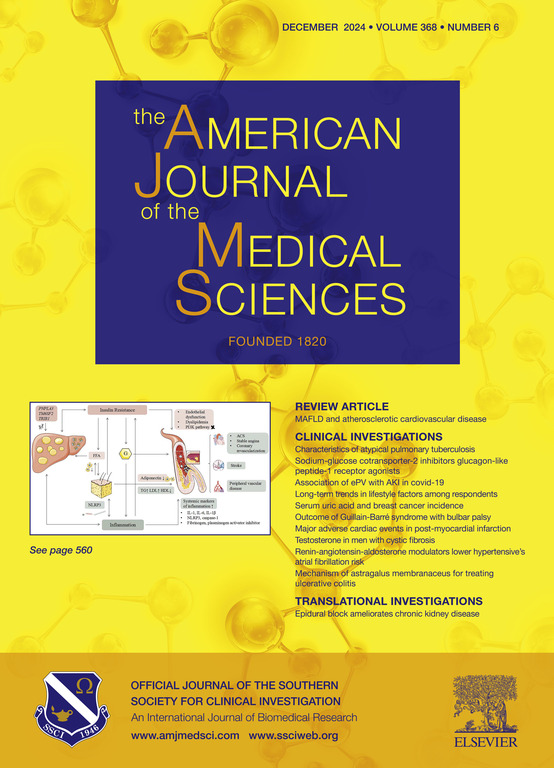Effect of genetic liability to migraines on spontaneous coronary artery dissection and fibromuscular dysplasia
IF 1.8
4区 医学
Q2 MEDICINE, GENERAL & INTERNAL
引用次数: 0
Abstract
Background
Associations among migraines, spontaneous coronary artery dissection (SCAD), and fibromuscular dysplasia (FMD) have been reported; however, their causality is inconclusive.
Methods
We inferred a causal relation between exposure (migraines) and outcomes (SCAD and FMD) using two-sample MR analysis. Mediation analysis was performed using reverse and multivariate MR analysis methods. Finally, using two-sample MR analysis, we explored whether the currently perceived potential risk factors for SCAD and FMD mediate the aforementioned causal association.
Results
Inverse Variance Weighted (IVW) analysis showed that migraines increased the risk of developing SCAD and FMD. SCAD increases the risk of developing FMD. Reverse causality or pleiotropy was not observed. Multivariate random IVW analysis showed that the effect of migraine on FMD was no longer significant in the multivariate model, whereas the effect of SCAD remained significant. SCAD mediated the causal association between migraine and FMD, with a mediating effect of 0.119 and a proportion of 18.30 %. IVW analyses did not find direct evidence that these associations were consistently related to other potential pathogenic factors of SCAD or FMD.
Conclusions
Migraines are a risk factor for both SCAD and FMD, whereas SCAD is an incomplete mediator of the causal relation between migraine and FMD. However, mechanistic studies are warranted to investigate this link.

偏头痛遗传易感性对自发性冠状动脉剥离和纤维肌肉发育不良的影响。
背景:偏头痛、自发性冠状动脉夹层(SCAD)和纤维肌肉发育不良(FMD)之间的关联已被报道;然而,它们之间的因果关系尚无定论。方法:我们通过双样本磁共振分析推断暴露(偏头痛)和结果(SCAD和FMD)之间的因果关系。采用反向和多变量磁共振分析方法进行中介分析。最后,通过双样本MR分析,我们探讨了SCAD和口蹄疫当前感知的潜在危险因素是否介导了上述因果关系。结果:逆方差加权(IVW)分析显示,偏头痛增加了SCAD和FMD的发生风险。SCAD增加了患口蹄疫的风险。未观察到反向因果关系或多效性。多变量随机IVW分析显示,在多变量模型中,偏头痛对FMD的影响不再显著,而SCAD的影响仍然显著。SCAD介导偏头痛与FMD的因果关系,其中介效应为0.119,比例为18.30%。IVW分析没有发现直接证据表明这些关联与SCAD或口蹄疫的其他潜在致病因素一致。结论:偏头痛是SCAD和FMD的危险因素,而SCAD是偏头痛和FMD因果关系的不完全中介。然而,有必要进行机制研究来调查这种联系。
本文章由计算机程序翻译,如有差异,请以英文原文为准。
求助全文
约1分钟内获得全文
求助全文
来源期刊
CiteScore
4.40
自引率
0.00%
发文量
303
审稿时长
1.5 months
期刊介绍:
The American Journal of The Medical Sciences (AJMS), founded in 1820, is the 2nd oldest medical journal in the United States. The AJMS is the official journal of the Southern Society for Clinical Investigation (SSCI). The SSCI is dedicated to the advancement of medical research and the exchange of knowledge, information and ideas. Its members are committed to mentoring future generations of medical investigators and promoting careers in academic medicine. The AJMS publishes, on a monthly basis, peer-reviewed articles in the field of internal medicine and its subspecialties, which include:
Original clinical and basic science investigations
Review articles
Online Images in the Medical Sciences
Special Features Include:
Patient-Centered Focused Reviews
History of Medicine
The Science of Medical Education.

 求助内容:
求助内容: 应助结果提醒方式:
应助结果提醒方式:


